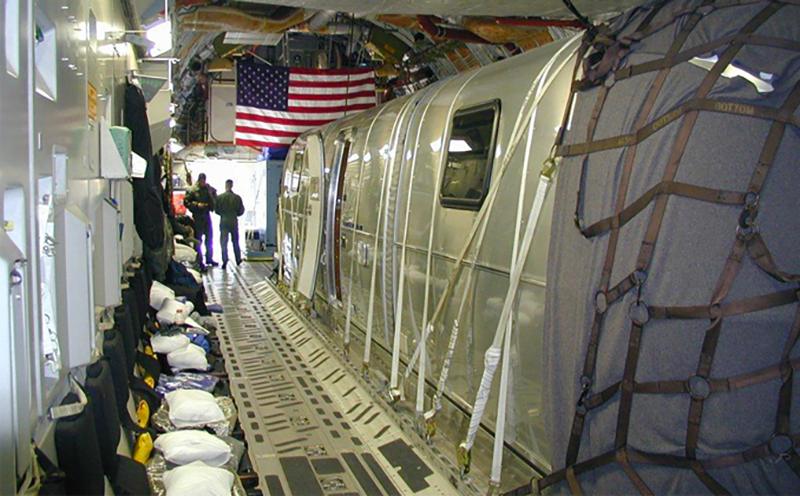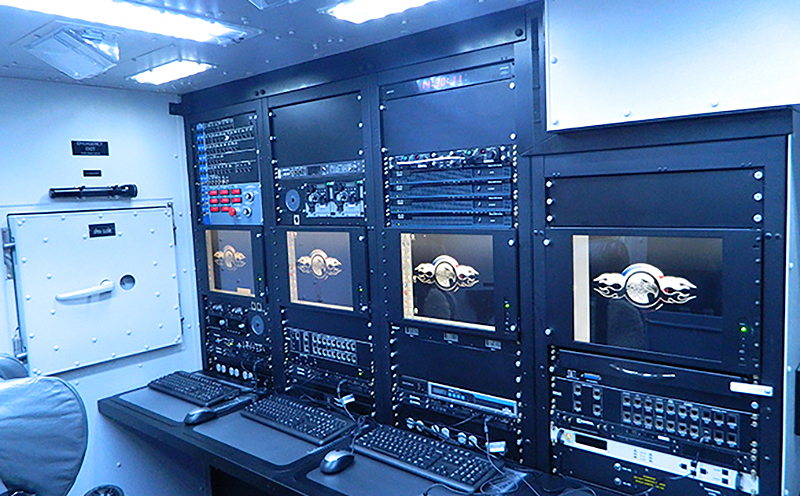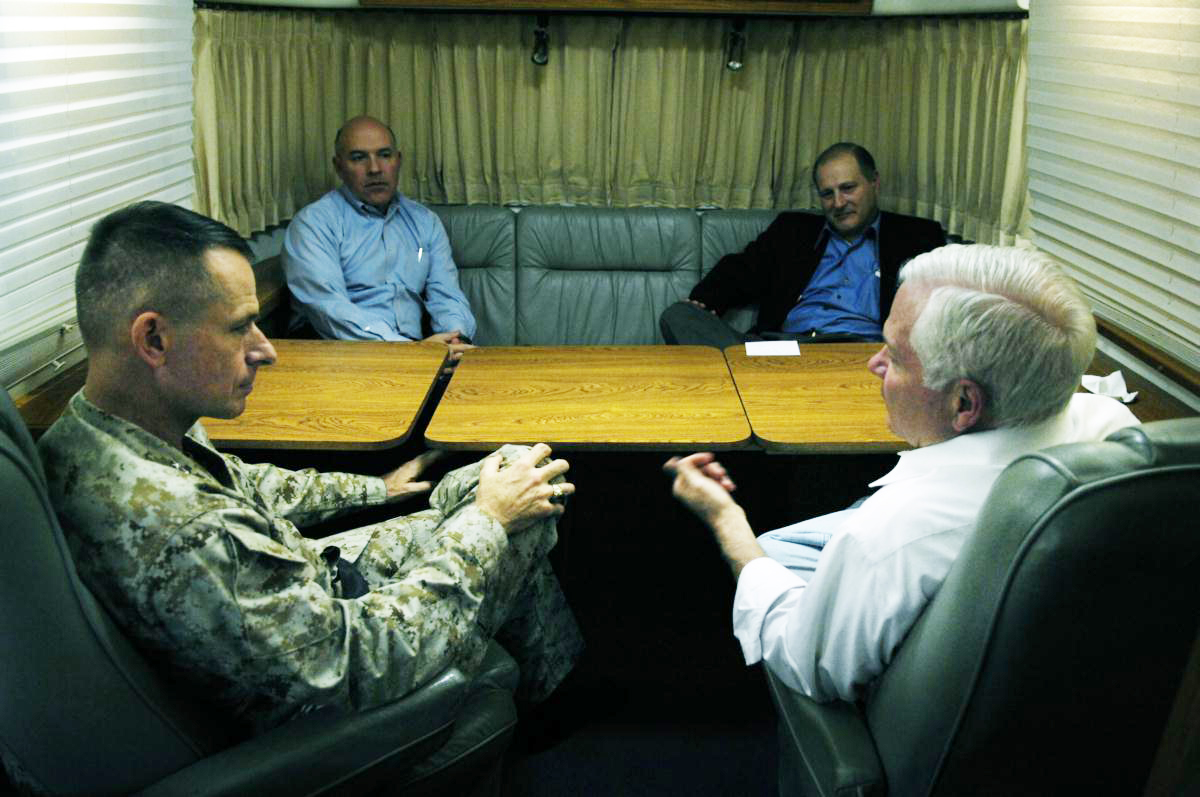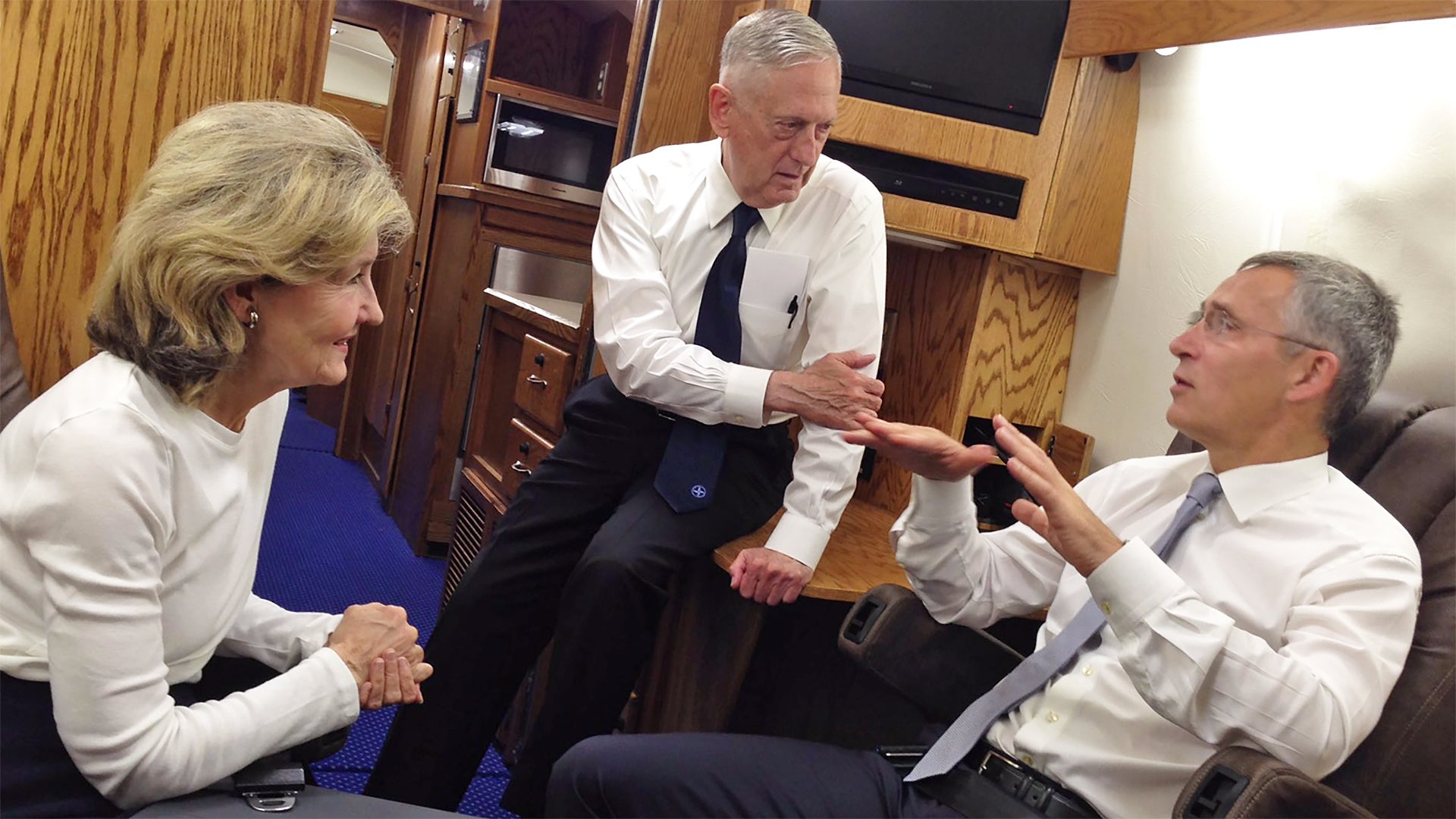Secretary of Defense Mattis just visited Afghanistan, where he had a very unwelcoming arrival thanks to RPG and mortar slinging Taliban insurgents. The Pentagon’s top civilian leader took a C-17 into the war torn country for good reason. The C-17 can maneuver hard within the tight confines of an airfield’s perimeter to execute tactical approaches and departures, and most importantly, they are equipped with an advanced countermeasures suite.
This defensive suite includes multiple types of expendable decoys and the latest version of the laser-based Large Aircraft Infrared Countermeasure System (LAIRCM). This system uses staring missile launch detectors arrayed around the aircraft that alert the crew of an incoming missile via detection of the missile’s infrared plume and cue a number of laser turrets positioned around the jet’s fuselage to fire their blinding beams into the missile’s infrared seeker.
This is a capability that most USAF airlifters now have to varying degrees, as well as some USAF VIP transports. The VC-25As that provide Presidential airlift as Air Force One are covered in the Direction Infrared Counter-Measures (DIRCM) turrets and the C-32As that often act as Air Force Two also have an enhanced version of the system. Some C-37s and C-40s sport less elaborate LAIRCM installations as well. But the latest C-17 LAIRCM outfits are among the most capable and combine their defensive abilities with the C-17s maneuverability and hardy airframe.

The Secretary of Defense’s usual ride, the E-4B National Airborne Operations Center (NAOC) doesn’t benefit from an elaborate infrared countermeasures suite and these aging aircraft have limited availability. But that doesn’t mean the Pentagon’s head honcho has to sit in an airliner seat bolted down in the C-17’s cargo hold the entire flight into a war zone. Instead he gets to use one of the Air Force’s two customized airstream VIP “Command and Control” (C2) pods aptly nicknamed “Silver Bullets.”
You can see the missile launch detector and the LAIRCM turret flanking the C-17’s main passenger door at the start of the video:
The Silver Bullets came out of a USAF Research Lab initiative dating back to around 1990. The idea was to get something modular that could provide a VVIP/distinguished guest the privacy required to discuss sensitive matters, while also being comfortable enough for them to relax or get work done while en route to a destination. Above all else they had to offer the connectivity required to provide officials with multiple forms of communications to the outside world. In addition, these “pods” of sorts had to be relatively affordable, so starting from scratch really didn’t make sense.
A 36 foot Airstream trailer was used as a starting point, with the trailer being turned into a three sectioned pod mounted on 12 foot long cargo pallets. The Airstream’s wheels, towing system, fuel tanks, and environmental systems were stripped and its shell was heavily insulated to work as something akin to a mobile SCIF. An arsenal of communications tech was integrated into the pod as well.

This included multiple radio and satellite systems for unsecure and secure voice, data, and video teleconferencing. These systems “plug in” to the existing communications systems aboard a select number of C-17s—supposedly it can be flown aboard some KC-10s as well—via a set of umbilical cables. There is a large “mechanical caboose” that brings up the rear of the palleted Silver Bullet system where the technology and controls that support the pod are held and where the pod’s electronics are interfaced with the C-17. The updated version of this enclosure is called the “Silver Eagle” and it can support communications at the very highest levels. The elite 21st Air Mobility Operations Squadron “Mobsters” mans the Silver Eagle system during deployments.

According to a section on the C-17’s future upgrade path within the Air Mobility Command’s official history report that the The War Zone obtained through the Freedom Of Information Act, the aircraft that can interface with the Silver Bullets have to be equipped with Secure En Route Communications Package (SECOMP) and Special Operations Low Level II (SOLL II) installation. McGuire AFB has C-17As—and presumably KC-10s—that are uniquely outfitted to support special operations missions and are equipped with these systems.

Even with all this high-tech communications gear, the largely windowless pods still look like recreational vehicles inside, with somewhat “quaint” wood finishing and leather accruements. They include a small galley, bathroom with shower, conference and office area and a sleeping/lounge area. Judging by the picture of Mattis inside the Silver Bullet on his trip to Afghanistan, we can tell that they have received a substantial electronics upgrade somewhat recently.

Outside of the pods, in the aircraft’s cavernous cargo hold, life goes on for aids and other passengers, with the Silver Bullet acting as an executive cocoon of sorts. Because they are not certified by the FAA, occupants can’t hang out inside of them during takeoff or landing. During those terminal operations they buckle into a seat just like everyone else but during cruise they have no real reason to leave as the pods even have oxygen at the ready for an emergency decompression situation and a direct line to the cockpit.

One of the units was originally based at Yokota Air Base in Japan but now they are both based at McGuire AFB in New Jersey and are maintained by the 605th Air Maintenance Squadron and operated by the 621st Air Mobility Operations Squadron. A crew of three accompanies each pod, which includes two stewards and a communications specialist to help operate the pod’s technical systems.
The Silver Bullets have seen use by a long list of officials and even celebrities. Beyond the Secretary of Defense, these have included Vice Presidents—most notably Dick Cheney who used the Silver Bullet extensively, the secretaries of the various services, Secretary of State, high-up military commanders, senators, and even Robin Williams and Drew Carey have used the mobile apartments of sorts during their travels to visit troops in war zones for the USO.

The Air Force has tried for over a decade to replace the Silver Bullets with something more lavish, certified for all phases of flight, and more technologically advanced. Two related programs from around 2008 drew disdain from government oversight group and the media. One was to produce a palleted system for “world class” first class style seating for VIPs called the Senior Leader In-transit Pallet (SLIP). The other program was to develop an enclosed executive suite called the Senior Leader In-transit Conference Capsule (SLICC).

These systems could fit on C-130s, KC-135s, KC-10s, and C-17s and could be linked together. The cost first the for the initial four SLIPs and one SLICC was said to have grown to nearly $5M, with the first SLICC, which includes a “comfort” capsule and a “conference capsule” that can be mated together, costing nearly three million by itself. The four SLIPs, which consist of just four chairs and a table area, would cost an incredible $415K each, or over $100k a seat.

Pogo noted the following on its blog in July of 2008:
“The program began under General Duncan McNabb’s tenure as commander of Air Mobility Command, a part of the Air Force that is responsible for air transport. General McNabb originally sought ten SLICCs and was involved in choosing the original color and material choices for the SLICC and SLIP leather, wood and carpet, which General Robert H. McMahon later changed at the tune of hundreds of thousands of dollars.
Disgust towards the generals’ requests grew inside the Air Force, leading the acquisition effort to be moved when one part of Air Mobility Command refused to make some of the costly changes.
“In Mar 07, Gen McMahon requested A4 [Air Mobility Command’s Logistics Directorate] take over the acquisition effort when he could not get support from A5 [AMC’s Plans and Programs Directorate] for updates and cooperation on making the equipment ‘world class’ which was one of his goals,” according to an Air Force email.
In one email it states, “Gen McMahon’s concern is so significant that we need assurance by the end of the week from AFRL [Air Force Research Laboratory] that the SLICC will be ‘World class’ inside. While we know the requirements document says ‘business class’, we all know there are levels of that.”
The “world class” emphasis entailed the costly aesthetic redesign of the interior of an already existing system known as Steel Eagle. After the first SLIP was procured, General McMahon expressed dissatisfaction with the color of the seat leather and type of wood used. He directed that the leather be reupholstered from brown to Air Force blue leather and to replace the wood originally used to cherry.
The cost alone to reupholster the seats on the first SLIP is about $21,000 – one estimate of the total cost of wood and leather changes to all the first four SLIPs (16 chairs total) was about $113,000. The cost was so appalling to General Kenneth Merchant that he wrote, “How’d we get to $113K for 4 pallets? Pls tell me this is for all 4 pallets…I could carpet and upholster a couple of houses for $113K…” (ellipses in original)
As of March this year, the total cost increase for retrofit and further customization –which goes beyond wood and leather – for the SLIPs, directed by Air Mobility Command headquarters, is $493,000…
…The money wasted here is a symbol of the disconnected and out-of-touch brass within the Air Force. Certainly there were some good guys here with a sense of perspective. As you can see above, General Kenneth Merchant had enough gumption to ask why these changes cost so much. But he was in the minority. Knowledge of the acquisition went even above General McNabb — then-Chief of Staff T. Michael “Buzz” Moseley was briefed on the SLICC program. And as an email states, “the expectation was high” for the program. As readers of this blog well know, Moseley was canned by Defense Secretary Robert Gates about a month ago.”

It does appear as if these programs made it at least through their initial order phase as SLIPs have been seen in use before. Hillary Clinton sat on one on her trip to Libya in 2011 and John Kerry was also photographed using SLIPs during his time as Secretary of State. It appears as if at least one SLIP was procured, but there seems to be no mention of it being used or photos of it being deployed operationally. This doesn’t necessarily mean it isn’t in still service to some capacity though.


The program was renamed the Roll-On Conference Capsule (ROCC) in 2017 and an official request for proposal was filed last June. The system could be used for more extensive command and control purposes than just for carting VIPs and commanders around, even working as a staffed mobile command center during specific operations or emergencies. The official statement of work attached to the program opens with the following:
“The ROCC will replace legacy Silver Bullet Modules, which are modified Airstream trailers that the USG has certified for transportation on mobility aircraft as cargo only. The project sponsor is Air Mobility Command. The acquirer is C‐17 Systems Program Office (SPO), which is part of the Air Force Life Cycle Management Center (AFLCMC) Mobility Directorate. End user customers of the ROCC are senior leaders of the US Department of Defense and their travel teams. Other USG agencies such the State Department may also use the ROCC. Supporting agencies include the Air Force Research Laboratory (AFRL) and the Air Transportation Test Loading Agency (ATTLA). The planned operating site for ROCC is at Joint Base Andrews, MD, and the planned depot maintenance site is at Wright Patterson AFB, OH.”
As to whether or not the USAF will be successful this time in replacing the Silver Bullets, we can’t be sure. VIP travel is under a microscope in Washington DC once again, and the President himself isn’t immune to the issue. In general, the concept of public officials using government or government chartered aircraft, especially lavish ones, has become an increasingly hot button topic over the last couple of decades. Still, the Secretary of Defense in particular has to stay in contact at all times to serve in the role of the second half of the National Command Authority. Should the President make the call to release nuclear weapons, the SecDef has to be there to give secondary approval, and having some sort of area and communications architecture conducive to that scenario is important while traveling.
In the meantime, the now somewhat wholesome Silver Bullets, with their ugly drapes and dated wood interior, will soldier on carrying America’s most powerful figures in and out of war zones around the globe.
Author’s note for correction: Silver Bullet operations have moved to Andrews AFB. The pods are maintained by the 89th Maintenance Group and the Steel Eagle comms unit is maintained by the 89th Communications Squadron. In flight support is provided by both 99th and 1st Airlift Squadrons. No C-17s are assigned to Andrews, so the aircraft are still pulled from bases with properly equipped aircraft. Considering that their mission is VIP transport, moving the pods to Andrews AFB makes a lot of sense.
Contact the author: Tyler@thedrive.com
